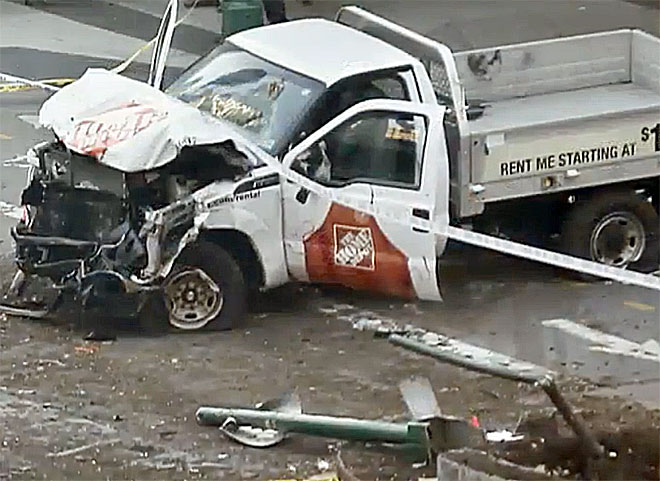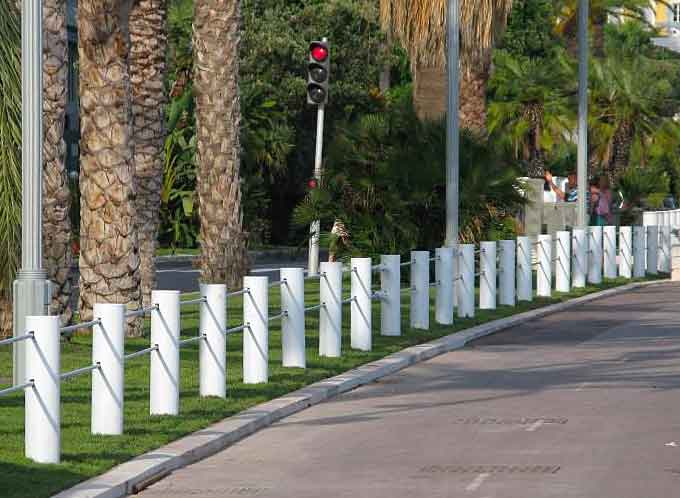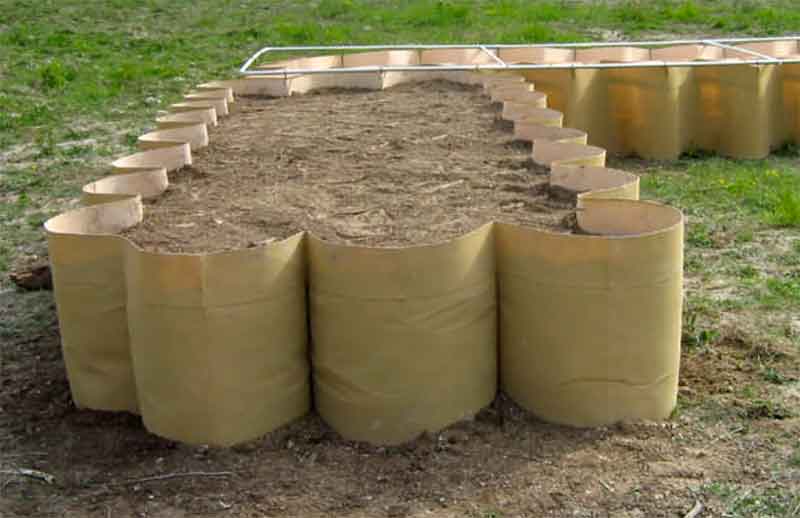
In January 2018, Bill de Blasio, the Mayor of New York, and the City’s Security Infrastructure Working Group announced plans to bring permanent perimeter barriers, or bollards, to high-profile sites and to create a process to streamline their design and construction.
With funds exceeding $14 million for permanent bollards in Time Square and in excess of $50 million to commence the broader rollout of new protective measures in phases.
“In 2017, New Yorkers witnessed the horrible capacity of people willing to do us harm, whether it was in our subways, on our bike paths or in Times Square,” said Mayor de Blasio.”
(An attack in New York City has left at least eight people dead and a dozen injured. A man in a pickup truck plowed through a busy bike path. Courtesy of The National and YouTube. Posted on Nov 1, 2017)
“But we will not be cowed and our expanded investment today in barriers and bollards in our public spaces underscores our resolve in keeping New York City safe from future attacks,” de Blasio.”
“In this new year, we can and will protect our iconic public spaces while New Yorkers go on living our lives, including by hosting a record number of tourists.”
“These additional safety bollards will allow New Yorkers and visitors to be more secure at landmark locations and other sites throughout our City,” added Police Commissioner James P. O’Neill.
With vehicles seemingly becoming the weapon of choice for terrorists, the need to protect citizens from “people willing to do us harm” has dawned on most large cities, leaving many still trying to find the best way to protect their citizens.
Admittedly in many cases, it seems to be “after the horse has bolted” so to speak.
In 2016 a lorry was driven into crowds celebrating Bastille Day in Nice, killing 87 people and injuring 458.
(At least 84 people have died, including children, after a lorry slammed through a crowd celebrating Bastille Day in the southern French city of Nice. The driver ploughed on for 2km on the Promenade des Anglais at about 23:00 local time, before being shot dead by police. Courtesy of BBC News and YouTube. Posted on Jul 14, 2016)
This was an awful, cowardly and devastating attack that had a huge impact on so many lives.
The stark reality is however, after two previous vehicle attacks in France, if there had had been tougher security measures in place, rather than an increased police presence, and a plastic temporary barrier, then many of those citizens would still be alive today.

Reacting to these devastating events, Metropolis Nice C.te d’Azur decided to install a safety barrier along the Promenade des Anglais.
The new barrier, or vehicle incursion prevention system, MacSafe, was tailor made for the Promenade des Anglais by Maccaferri and J&S Franklin.
It was inaugurated in July 2017.
It is crash test rated to stop a 19-tonne truck traveling at 50km/h and impacting at 20°, equivalent to the vehicle used by the terrorist in Nice in 2016 and can withstand two successive impacts.
The system is also accredited by the UIAU (University of Venice).

The MacSafe system consists of two high tensile steel cables supported on tubular steel posts and anchored at each end with our patented energy dissipation system.
The posts are secured to ground foundations and all external fixings are designed to prevent them being easily removed.
The force of the vehicle impact is distributed through the cables and posts and absorbed within the patented energy dissipaters.
The energy is absorbed through compressive deformation and not by friction.

This ensures better and more reliable performance throughout the long-life of the barrier.
On the 19th December 2016, a truck was deliberately driven into the Christmas market next to the Kaiser Wilhelm Memorial Church at Breitscheidplatz in Berlin, killing 12 people and injuring 56 others.
(At least nine people have been killed after a lorry crashed into a crowded Christmas market in Berlin. Emma Rushton witnessed what happened and told Sky’s Dermot Murnaghan “It wasn’t an accident.” Courtesy of Sky News and YouTube. Posted on Dec 19, 2016)
One year on, and the Christmas Market in Berlin is protected by large concrete barriers, armed police patrols and stop and search checks.
January 2017 – In Melbourne, 6 people were killed and 37 injured when a car sped down a footpath crashing into pedestrians, by June 2017 $10 million had been allocated, and temporary concrete barricades and bollards had been installed around the City of Sydney.
(The driver of a car which plowed into Christmas shoppers in Melbourne a history of drug use and mental health issues, police said. Eighteen people were injured, including at least one young child, when the car hit pedestrians outside Melbourne’s iconic Flinders Street station just after 4.40 p.m. local time. Courtesy of CNN and YouTube. Posted on Dec 21, 2017)
In January 2018, the City of Gold Coast began installing heavy duty retractable bollards capable of repelling the force of a large heavy goods vehicle.
They had previously resolved to spend $515,000 on bollards which met the Australian standard, but on the advice of the QPS Commonwealth Games security adviser, it was recommended that the bollards comply with a European standard bringing the cost of the project to $1.095 million.
Las Vegas, plan to have their existing 800 bollards, updated to some 7,000 by the end of 2018, in an effort to increase the safety of those walking The Strip in Sin City.
(Bollards or steel posts are being installed on Las Vegas Boulevard to make it safer for pedestrians. Courtesy of KTNV Channel 13 Las Vegas and YouTube. Posted on Nov 13, 2017)
However, some Cities are still concerned about the aesthetics of concrete bollards on their historic cities, a case of balancing security over protecting tourism.
Take for instance, Barcelona in Spain.
On the 17th August 2017, a van was driven into pedestrians strolling along Las Ramblas, in Barcelona, killing 13 people and injuring at least another 130.
(WARNING: Graphic Images: At least 12 people were killed and dozens more injured after a van plowed through a crowd on Las Ramblas avenue in Barcelona, Spain. Courtesy of CNN and YouTube. Posted on Aug 17, 2017)
Advice was given that bollards were needed, warnings of impeding threats were given, and yet, the action taken was to increase policing levels on the streets.
Now, thankfully, there are a few bollards and increased police on the streets, and going forward they are “studying the possibility of installing physical barriers to prevent further attacks with vehicles”
In London on 22nd March 2017, a car was driven into pedestrians on Westminster Bridge, killing 5 people and injuring 49 others. The driver also stabbed a policeman to death.
(Attacker who reportedly stabbed an officer is shot by police, car seen running down pedestrians on Westminster Bridge. Courtesy of CBC News and YouTube. Posted on Mar 22, 2017)
Again, in London, on 3rd June 2017, a van was driven at pedestrians in the London Bridge Area.
Three attackers began stabbing people, before being shot by police. 8 people died. 48 were injured, 21 critically.
Controversially previously installed “Guard Rails” had been removed from London’s Streets in an effort to protect cyclists and make the Capital more “attractive”.
Although Guard Rails would not have stopped either London attack they could have limited the results.
(Six people were killed and at least 48 injured in a terror incident in London in which three male attackers were shot dead by police after a white van hit pedestrians on London Bridge. Courtesy of BBC News and YouTube. Posted on Jun 3, 2017)
However, today, protective barriers are erected on Thames bridges and from London’s experience of previous terrorist activities (IRA) there are very few buildings or indeed public spaces that don’t have “counter-terrorism” design inbuilt.
The UK Government has produced a 174-page guide, Crowded Places Guidance, that highlights the threat as a vehicle being used as a weapon, but also highlights that these threats can be “mitigated by installing physical measures (including blending into the landscape or streetscape) which may be passive (static) or active (security controlled).
These measures can be installed either on a permanent or temporary basis.
All such measures should meet appropriate standards in terms of their vehicle impact performance, design and installation.

Vehicle Security Barriers, need not be ugly concrete monstrosities.
Nor do they need to be concrete lumps that need huge lifting gear to place them.
They can be totally inconspicuous, letting everyday life continue and forgetting they are there, or full on “in your face” shouting a warning to would be terrorists that this area is safe.
They come in many guises, from retractable bollards and passive static bollards to street furniture.
Even cleverly disguised PAS68 Street Planters from Securiscape, which have an attractive floral display whilst cleverly acting as a security barrier.
(Animation illustrating security bollards, furniture & planters. Courtesy of ODTV and YouTube)
These planters can be installed quickly and are sited to allow pedestrians to pass through while vehicles can’t, but due to intelligent design, incorporating a surface mounted, reinforced structure which can stop a vehicle if it is used as a battering ram.

But if none of that appeals, then there are many Landscaping options, including, ditches, bunds and berms.
DefenCell by J&S Franklin, is a lightweight geotextile welded mesh gabion that once filled with locally available materials, can be incorporated into security measures for public places and protection.
Filled and stacked, these gabions can be covered and planted, maintaining the aesthetic and environmental considerations of high profile or sensitive locations.
(DefenCell has been extensively tested for Homeland Security applications providing Critical Infrastructure Protection including perimeter security, vehicle barriers and inspection lanes as well as temporary or permanent barriers. Courtesy of DefenCell and YouTube)
Sadly, people with “evil intent” are a fact of life. Which makes Vehicle Security Barriers a permanent part of our city landscapes.
So, whether hidden or in plain sight they will be there be to Protect and Protect again.

J&S Franklin Ltd was founded in 1946, and remains a compact family-run business, with over 20 staff in two UK locations, offering a wide range of military and civil equipment to the British Ministry of Defence, and many overseas Governments, International Relief Agencies and the United Nations.
J & S Franklin offers a complete “turnkey” service, combining rapid response, confidentiality and experience to provide economical and effective solutions, on a global basis.
Learn More…
A Lethal Mix: High-Occ Spaces & Moving Vehicle Threats (Learn More)
Crash Barriers as ‘Street Furniture’ – Why Functional Will No Longer Do















